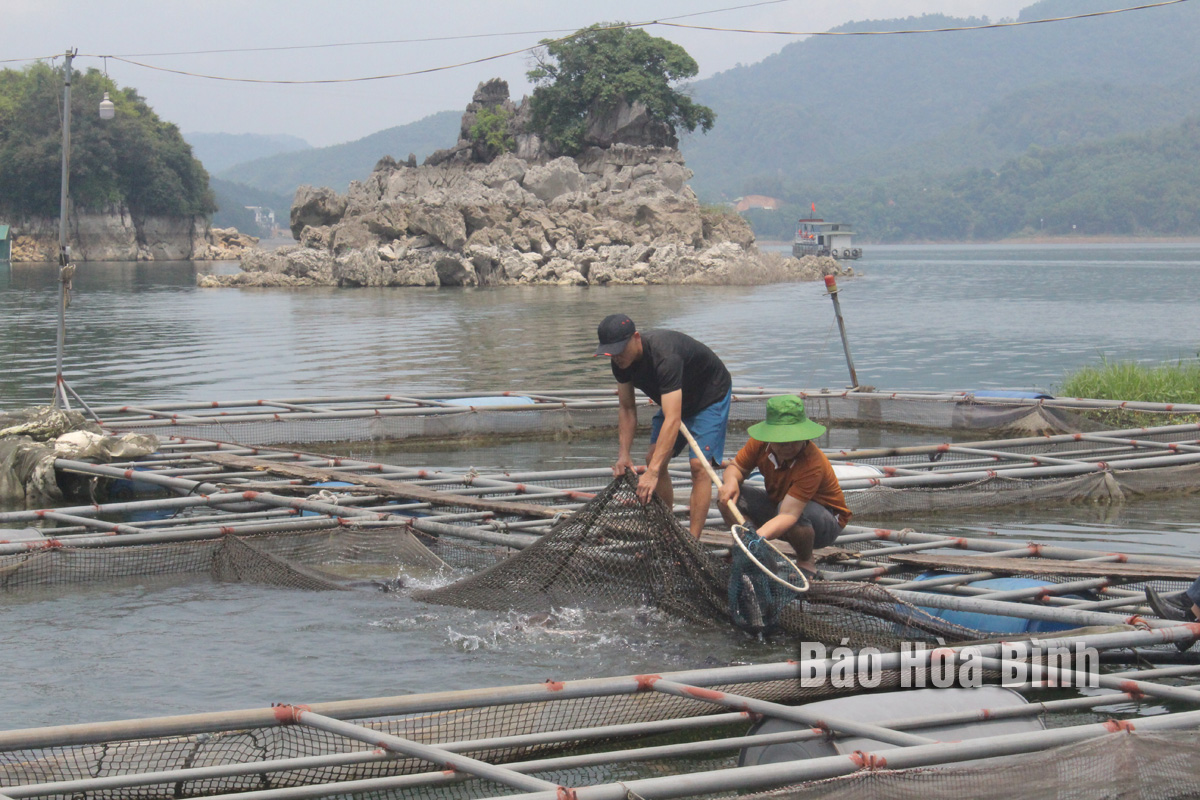
By the end of June 2024, Hoa Binh province has 9 processed seafood products
recognized with OCOP 3 and 4 star standards. Building and developing OCOP
products is one of the important solutions to develop sustainable aquaculture.
Developing OCOP products helps increase the value of aquatic products. Photo taken in Binh Thanh commune, Cao Phong district, Hoa Binh province.
With a large hydroelectric lake, Hoa Binh is one of the five provinces with the greatest potential in the country for economic development of lake fisheries. In recent years, Hoa Binh province has issued policies to encourage and support the development of sustainable cage fish farming; building the brands "Da River Fish - Hoa Binh" and "Da River Shrimp - Hoa Binh" (certified by the Department of Intellectual Property).
In addition, Hoa Binh province promoted the development of OCOP aquatic products and brought practical results in promoting and consuming the products. Up to now, Hoa Binh province has 9 processed products (fish fillets, fish floss) certified with OCOP, including: 5 products with 4 stars and 4 products with 3 stars.
In 2023, Da River black carp and Da River barbel fish are products of Da Giang ECO Cooperative, Tien Phong commune, Da Bac district that are recognized as 3-star OCOP products. With 5 hamlets bordering Hoa Binh hydroelectric lake, cage fish farming has developed in this commune.
Comrade Bui Khac Vinh, Head of the Department of Agriculture and Rural Development of Da Bac district, Hoa Binh province said: Building OCOP products on fisheries is one of the important solutions that the district has been implementing to develop OCOP products. Develop cage fish farming commensurate with its potential and advantages.
Comrade Luong Thanh Hai, Director of Hoa Binh Provincial Department of Fisheries said: Currently, the Agriculture and Rural Development sector focuses on testing cage fish farming models according to VietGAP standards; build and develop OCOP products to improve product quality and value. Besides, build chain link models from seed production, farming, processing, and marketing. Encourage the development of cooperatives, linking production with product consumption in a concentrated, large-scale manner associated with the application of quality standards.
According to data from the Hoa Binh Provincial Party Committee, the industrial production index for the first six months of 2025 is estimated to have increased by 20% compared to the same period last year. This marks the highest year-on-year growth rate for this period since 2020.
In the first six months of 2025, Hoa Binh province’s export turnover was estimated at 1.145 billion USD, marking an 18.11% increase compared to the same period in 2024. Import turnover was estimated at $ 804 million, a 17.15% increase, which helped the province maintain a positive trade balance.
The lives of the ethnic minority farmers in Tan Lac district have gradually improved thanks to the new directions in agricultural production. This is a testament to the collective strength fostered through the professional associations and groups implemented by various levels of the district’s Farmers’ Union.
With the motto the "product quality comes first,” after nearly one year of establishment and operation, Muong village’s Clean Food Agricultural and Commercial Cooperative, located in Cau Hamlet, Hung Son Commune (Kim Boi district), has launched reputable, high-quality agricultural products to the market that are well-received by consumers. The products such as Muong village’s pork sausage, salt-cured chicken, and salt-cured pork hocks have gradually carved out a place in the market and they are on the path to obtaining the OCOP certification.
In the past, the phrase "bumper harvest, rock-bottom prices" was a familiar refrain for Vietnamese farmers engaged in fragmented, small-scale agriculture. But today, a new spirit is emerging across rural areas of Hoa Binh province - one of collaboration, organisation, and collective economic models that provide a stable foundation for production.
Maintaining growing area codes and packing facility codes in accordance with regulations is a mandatory requirement for agricultural products to be eligible for export. Recently, the Department of Agriculture and Environment of Hoa Binh province has intensified technical supervision of designated farming areas and packing facilities to safeguard the "green passport" that enables its products to access international markets.



